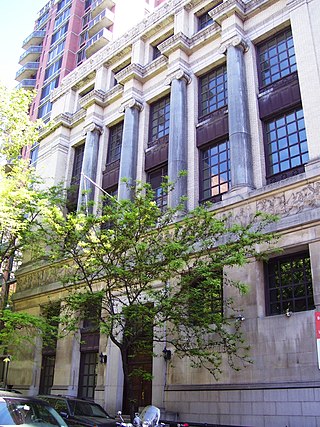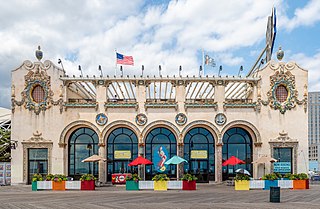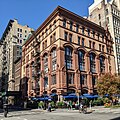
90 West Street is a 23-story residential building in the Financial District of Lower Manhattan in New York City. Located on West Street just south of the World Trade Center, the building was designed by Cass Gilbert, with Gunvald Aus and Burt Harrison as structural engineers, and John Peirce as general contractor. It was erected for the West Street Improvement Corporation, led by transportation magnate Howard Carroll.
Mather Tower is a Neo-Gothic, terra cotta-clad high-rise structure in Chicago, Illinois, United States. It is located at 75 East Wacker Drive in the downtown "loop" area, adjacent to the Chicago River.

Francis Hatch Kimball was an American architect practicing in New York City, best known for his work on skyscrapers in lower Manhattan and terra-cotta ornamentation. He was an associate with the firm Kimball & Thompson. His work includes the Empire Building, Manhattan Life Insurance Building, and Casino Theatre. All but one of Kimball's works were in the United States.

Glazed architectural terra cotta is a ceramic masonry building material used as a decorative skin. It featured widely in the 'terracotta revival' from the 1880s until the 1930s. It was used in the UK, United States, Canada and Australia and is still one of the most common building materials found in U.S. urban environments. It is the glazed version of architectural terracotta; the material in both its glazed and unglazed versions is sturdy and relatively inexpensive, and can be molded into richly ornamented detail. Glazed terra-cotta played a significant role in architectural styles such as the Chicago School and Beaux-Arts architecture.

The Guaranty Building, formerly called the Prudential Building, is an early skyscraper in Buffalo, New York. It was designed by Louis Sullivan and Dankmar Adler and completed in 1896. The building has been declared a National Historic Landmark and is located within the Joseph Ellicott Historic District.

The American Terracotta Tile and Ceramic Company was founded in 1881; originally as Spring Valley Tile Works; in Terra Cotta, Illinois, between Crystal Lake, Illinois and McHenry, Illinois near Chicago by William Day Gates. It became the country's first manufactury of architectural terracotta in 1889. The production consisted of drain tile, brick, chimney tops, finials, urns, and other economically fireproof building materials. Gates used the facilities to experiment with clays and glazes in an effort to design a line of art pottery which led to the introduction of Teco Pottery. American Terra Cotta's records are housed at the University of Minnesota and include original architectural drawings.

Architectural terracotta refers to a fired mixture of clay and water that can be used in a non-structural, semi-structural, or structural capacity on the exterior or interior of a building. Terracotta pottery, as earthenware is called when not used for vessels, is an ancient building material that translates from Latin as "baked earth". Some architectural terracotta is actually stronger than stoneware. It can be unglazed, painted, slip glazed, or glazed.

The New York School of Applied Design for Women, established in 1892 by Ellen Dunlap Hopkins, was an early design school for women in New York City. The 1908 New York School of Applied Design building was designed by Harvey Wiley Corbett and is now landmarked.

The Atlantic Terra Cotta Company was established in 1879 as the Perth Amboy Terra Cotta in Perth Amboy, New Jersey due to rich regional supplies of clay. It was one of the first successful glazed architectural terra-cotta companies in the United States.

The Potter Building is a building in the Financial District of Manhattan in New York City. The building occupies a full block along Beekman Street with the addresses 38 Park Row to its west and 145 Nassau Street to its east. It was designed by Norris G. Starkweather in a combination of the Queen Anne and neo-Grec styles, as an iron-framed structure.

The Broadway–Chambers Building is an 18-story office building at 277 Broadway, on the northwest corner with Chambers Street, in the Civic Center and Tribeca neighborhoods of Manhattan in New York City. Completed by 1900 to designs by architect Cass Gilbert, the Broadway–Chambers Building was the first of several that Gilbert designed in the city.

The Schermerhorn Building is a historic structure at 376–380 Lafayette Street, on the northwest corner with Great Jones Street, in the NoHo neighborhood of Manhattan in New York City. It was built in 1888–1889 by William C. Schermerhorn on the site of the Schermerhorn mansion, and rented by him to a boys' clothing manufacturer. The Romanesque Revival loft building was designed by Henry Hardenbergh, architect of the Plaza Hotel and The Dakota. The building is constructed of brownstone, sandstone, terra-cotta and wood, and has dwarf columns made of marble.

The Childs Restaurant Building on the Boardwalk is a New York City designated landmark on the Riegelmann Boardwalk at West 21st Street in Coney Island, Brooklyn, New York City. It was completed in 1923 for Childs Restaurants, an early restaurant chain and one of the largest in the United States at that time. It was designed in a "resort style with Spanish Revival influence" with colorful exterior terra cotta ornamentation that references its seaside location, with depictions of Poseidon, sailing ships, and sea creatures. It was a very large restaurant, with three stories and a roof garden.

John Marriott Blashfield (1811–1882) was a property developer and mosaic floor and ornamental terracotta manufacturer. He originally worked for the cement makers Wyatt, Parker and & Co in Millwall, but moved the business to Stamford in Lincolnshire in 1858, when it was renamed The Stamford Terracotta Company.

Sohmer and Company Piano Factory is a historic piano factory located in the Astoria neighborhood of Queens, New York City. It was built in 1886 by Sohmer & Co., and is a six-story, L-shaped, Rundbogenstil / Romanesque Revival style brick building. The corner features a clock tower with a copper trimmed mansard roof. The building was expanded about 1906–1907. It was converted to residential usage starting in 2007.

The Jamaica Savings Bank is a building at Jamaica Avenue and Sutphin Boulevard in Jamaica, Queens, New York City. The building was built between 1938 and 1939 in the Art Deco style. It replaced the Queensboro Savings Bank at 90-55 Sutphin Boulevard, which was acquired by the Jamaica Savings Bank in 1934 and demolished in 1938. The address was changed to the current 146-21 Jamaica Avenue and is a New York City designated landmark.

Ely Walker Lofts is a building located at 1520 Washington Avenue in St. Louis, Missouri.

165 West 57th Street, originally the Louis H. Chalif Normal School of Dancing headquarters, is a building in the Midtown Manhattan neighborhood of New York City. It is along the northern sidewalk of 57th Street between Sixth Avenue and Seventh Avenue. The five-story building was designed by George A. and Henry Boehm for dance instructor Louis H. Chalif. It was designed as an event space, a school, and Chalif's apartment.

130 West 30th Street, also known as The Cass Gilbert, is a luxury condominium on 30th Street between the Avenue of the Americas and Seventh Avenue in Midtown Manhattan in New York City. The 18-story building was designed by Cass Gilbert in the Assyrian Revival style as offices, showrooms and manufacturing space in the Garment District. The building is a New York City designated landmark.
James Taylor (1839–1898) was an English-born ceramicist who is considered "the father of the American architectural terra cotta industry."























